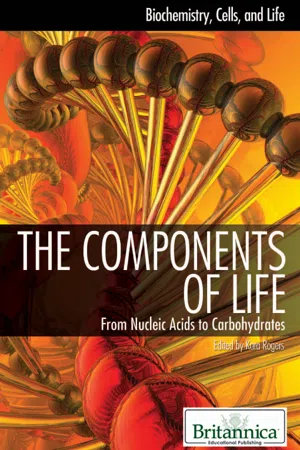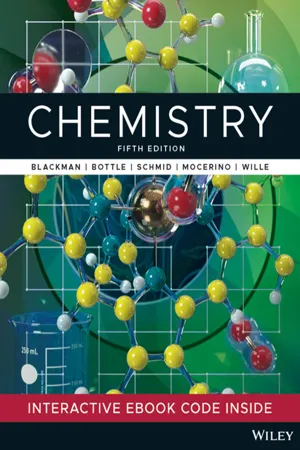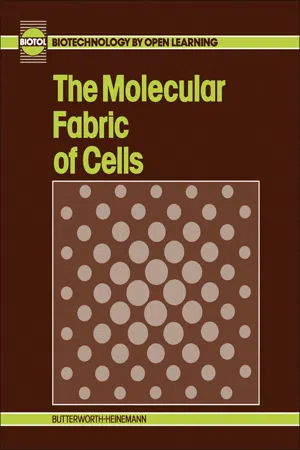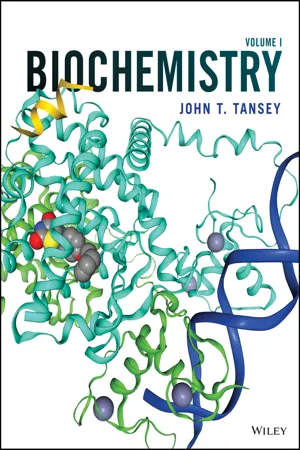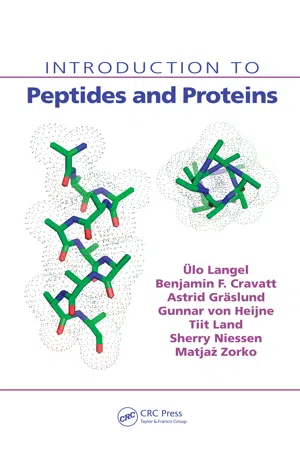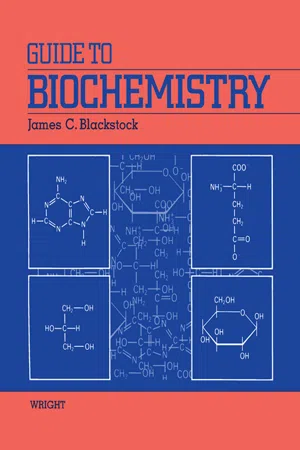Chemistry
Basic Amino Acids
Basic amino acids are a group of amino acids that have a positively charged side chain at physiological pH. This charge is due to the presence of an amino group in their side chains. Examples of basic amino acids include lysine, arginine, and histidine. These amino acids play important roles in protein structure and function, as well as in various biochemical processes within the body.
Written by Perlego with AI-assistance
Related key terms
1 of 5
11 Key excerpts on "Basic Amino Acids"
- eBook - ePub
The Components of Life
From Nucleic Acids to Carbohydrates
- Britannica Educational Publishing, Kara Rogers(Authors)
- 2010(Publication Date)
- Britannica Educational Publishing(Publisher)
CHAPTER 2Molecular Components: Amino AcidA mino acids are organic molecules that consist of a basic amino group (-NH2 ), an acidic carboxyl group (-COOH), and an organic R group (or side chain) that is unique to each amino acid. The term amino acid is short for “α-amino [alpha-amino] carboxylic acid.” Each molecule contains a central carbon (C) atom, termed the α-carbon, to which both an amino and a carboxyl group are attached. The remaining two bonds of the α-carbon atom are generally satisfied by a hydrogen (H) atom and the R group. The formula of a general amino acid is:The amino acids differ from each other in the particular chemical structure of their R group. Of over 100 natural amino acids, each with a different R group, only 20 make up the proteins of all living organisms. Humans can synthesize 10 of them (by interconversions, or mutual conversions) from each other or from other molecules of intermediary metabolism, but the other 10 (essential amino acids: arginine, histidine, isoleucine, leucine, lysine, methionine, phenylalanine, threonine, tryptophan, and valine) must be consumed in the diet.BUILDING BLOCKS OF PROTEINS
Proteins are of primary importance to the continuing functioning of life on Earth. Proteins catalyze the vast majority of chemical reactions that occur in the cell. They provide many of the structural elements of a cell, and they help to bind cells together into tissues. Some proteins act as contractile elements to make movement possible. Others are responsible for the transport of vital materials from the outside of the cell (“extracellular”) to its inside (“intracellular”). Proteins, in the form of antibodies, protect animals from disease and, in the form of interferon, mount an intracellular attack against viruses that have eluded destruction by the antibodies and other immune system defenses. Many hormones are proteins. Last but certainly not least, proteins control the activity of genes (“gene expression”). - eBook - PDF
- Allan Blackman, Steven E. Bottle, Siegbert Schmid, Mauro Mocerino, Uta Wille(Authors)
- 2022(Publication Date)
- Wiley(Publisher)
CHAPTER 24 Amino acids, peptides and proteins LEARNING OBJECTIVES After studying this chapter, you should be able to: 24.1 define the structure of amino acids 24.2 control the charge present on amino acids using pH 24.3 describe the linking of amino acids together to make peptides and proteins 24.4 categorise protein structures as 1°, 2°, 3° or 4° 24.5 explain the functional importance of the three-dimensional shape of proteins 24.6 exploit chemical and physical processes to change protein properties. Amino acids are molecules that contain both an amine functional group (described in the chapter on alcohols, amines and related compounds) and a carboxylic acid functional group (described in the chapter on carboxylic acids). Amino acids are important in their own right, but they are also critically important for life as they provide the building blocks of peptides and proteins. In this chapter we will look at the acid– base properties of amino acids, as these control much of the nature of peptides and proteins. Understanding the chemistry of amino acids allows us in turn to understand the more complex structures and properties of peptides and proteins. Proteins are among the most important of all biological compounds as they are integrally important in the vital functions of: • movement: muscle fibres are made of proteins called myosin and actin • catalysis: virtually all 1that take place in living systems are catalysed by a special group of proteins called enzymes • structure: structural proteins such as collagen and keratin are the chief constituents of skin, bones, hair and fingernails • transport: the protein haemoglobin is responsible for the transport of oxygen from the lungs to tissues, while other proteins transport molecules across cell membranes • protection: a group of proteins called antibodies represent one of the body’s major defences against disease. Peptides are a major component of the supplements and health food sector. - eBook - PDF
Polysaccharides Peptides and Proteins
Pharmaceutical Monographs
- R. T. Coutts, G. A. Smail, J. B. Stenlake(Authors)
- 2014(Publication Date)
- Butterworth-Heinemann(Publisher)
To the organic chemist an amino acid refers to any molecule possessing both an amino and an acid group. The bio-chemist, on the other hand, tends to reserve the term for those compounds in which an amino group occurs on the same carbon atom as a carboxyl group—α-amino acids (I)—and which have largely been isolated from protein hydrolysates. H H I I R—C—COOH R—C—COO~ I I NH 2 NH 3 (I) + da) 80 AMINO ACIDS The side group (R in I) in most cases is neutral and thus the amino acid is neutral since under most conditions it is the salt-like dipolarionic form (la) which is favoured. A few amino acids con-tain a second acidic or basic function in the side-chain and the molecule as a whole then departs from neutrality. Table 2 illus-trates the common amino acids of which proteins are largely com-posed, whereas Table 3 shows amino acids which are of less com-mon occurrence and are not all derived from proteins. In general the salt-like nature of the amino acids confers on them characteris-tic non-volatility, classical insolubility in organic solvents and high indefinite melting points which are almost invariably accom-panied by decomposition. The condensation of the amino group of one amino acid with the carboxyl group of another and the elimination of water results in the formation of a peptide linkage (—CONH—). Two or more amino acids joined by this linkage represents a peptide, and the prefixes di-, tri-, tetra-, etc. indicate the number of constituent amino acids. The term oligo-peptide is sometimes used to refer generally to these smaller peptides. The term polypeptide can be used to designate all but the simplest peptides. The proteins con-stitute the largest group of anhydrocopolymers of amino acids. An arbitrary distinction is usually drawn between polypeptides and proteins on a basis of molecular weight. The term polypeptide is usually reserved for those molecules whose molecular weight is less than 10,000. - Rifat Latifi, Stanley J. Dudrick(Authors)
- 2003(Publication Date)
- CRC Press(Publisher)
C hapter З Biochemistry of Amino Acids: Clinical Implications Rifat Latifi , Khawaja Aizimuddin Introduction Ajnino acids, as organic compounds, containing both an amino group and a carboxylic acid group, are the monomeric and basic constituents of all proteins. Amino acids occurring in protein are known as alpha-amino acids and have one or two empirical formulae RCH (NH+)COOH' or R-CH-(NH3)COO Beta-amino acids and gamma-amino acids also occur in nature but are not components of pro teins, and their significance is not known. This chapter reviews the basic biochemis try and physiology of amino acids and their functions as fundamental units of proteins. Their increasingly recognized and valued role in the metabolic and nutritional man agement of critically ill patients will be discussed through out this volume. Structure of Amino Acid and Proteins A protein molecule consists of amino acids held together by peptide bonds, which form a long polypeptide chain. The exact sequence of amino acids in the chain, referred to as the primary structure of the protein, is determined genetically and defines how the chain is folded into more complex conformations or shapes. A polypeptide, which is folded into a helical or pleated sheet configuration, is referred to as a secondary structure. If the sequence of amino acids is then folded into a three-dimensional configuration, a tertiary structure is created. Some pro teins have a higher level of molecular architecture known as the quaternary struc ture, in which several chains aggregate and function as a unit. The amino acid sequence and protein structure determine the nature and function of protein molecules upon which virtually every process of life depends. The folding of polypeptide chains into alpha helix and beta pleated sheets has clinical implications. The alpha helix is a rod-like structure and contains a tightly coiled polypeptide main chain.- eBook - PDF
- H. Stephen Stoker(Author)
- 2015(Publication Date)
- Cengage Learning EMEA(Publisher)
All Rights Reserved. May not be copied, scanned, or duplicated, in whole or in part. Due to electronic rights, some third party content may be suppressed from the eBook and/or eChapter(s). Editorial review has deemed that any suppressed content does not materially affect the overall learning experience. Cengage Learning reserves the right to remove additional content at any time if subsequent rights restrictions require it. 9-2 Amino Acids: The Building Blocks for Proteins 359 The three types of polar amino acids have varying degrees of affinity for water. Within a protein, such amino acids are considered to be hydrophilic (Section 8-7). A polar neutral amino acid is an amino acid that contains one amino group, one car-boxyl group, and a side chain that is polar but neutral. In solution at physiological pH, the side chain of a polar neutral amino acid is neither acidic nor basic. There are six polar neutral amino acids. These amino acids are more soluble in water than the non-polar amino acids as, in each case, the R group present can hydrogen-bond to water. ◀ A polar acidic amino acid is an amino acid that contains one amino group and two carboxyl groups, the second carboxyl group being part of the side chain. In solution at physiological pH, the side chain of a polar acidic amino acid bears a negative charge; the side-chain carboxyl group has lost its acidic hydrogen atom. There are two polar acidic amino acids: aspartic acid and glutamic acid. A polar basic amino acid is an amino acid that contains two amino groups and one carboxyl group, the second amino group being part of the side chain. In solution at physi-ological pH, the side chain of a polar basic amino acid bears a positive charge; the nitrogen atom of the amino group has accepted a proton (basic behavior; Section 6-6). There are three polar Basic Amino Acids: lysine, arginine, and histidine. ◀ The names of the standard amino acids are often abbreviated using three-letter codes. - Michael EJ Lean(Author)
- 2006(Publication Date)
- CRC Press(Publisher)
Those amino acids marked with the letter ‘E’ in Table 10.1 are known as essential (or indispensable) amino acids, meaning either that they cannot be made by the body or that they cannot be made fast enough to meet the body’s needs. Such amino acids must always be supplied by the diet. Eight amino acids are essential for adults and a further two – arginine and histidine – are essential for infants. During illness, the capacity for amino acid synthesis may be reduced so that other amino acids become ‘essential’. For example, glycine may be required from the diet during ‘conditioned essentiality’ as a result of illness, especially in infancy. Properties of amino acids Amino acids are white crystalline substances that are soluble to some extent in water but which are mostly insoluble in organic solvents. The amino group, as its name suggests, is related to ammonia and like ammonia it has basic characteristics, while the carboxyl group is acidic. The combination of an amino group and a carboxyl group in the same mol-ecule results in it being able to act as an acid or a base; such a substance is said to be amphoteric. The formulae in Table 10.1 show the arrange-ment of covalent bonds in amino acids but they CH 3 COOH CH 2 NH 2 COOH CHRNH 2 COOH Acetic acid Glycine General formula H H 2 N C C H OH O H H 2 N C C R OH O H H C C H OH O 134 Amino acids and proteins do not show the ionic character which amino acids display in solution. In solution amino acids may be more correctly represented as follows: This formula shows the ionic character of an amino acid and that it contains both a positive and a negative group. Amino acids are weak electrolytes and they ionize according to the pH of the system. We can represent this ionization as: NH 3 CH R COO NH 3 NH 3 NH 2 CH R R R CH CH COOH COO COO Positive ion Negative ion Zwitterion acid alkali H H Table 10.1 Structure of amino acids, H 2 NCHRCOOH.- eBook - PDF
- BIOTOL, B C Currell, R C E Dam-Mieras(Authors)
- 2013(Publication Date)
- Butterworth-Heinemann(Publisher)
In this chapter we will examine the structure and properties of these building blocks before examining proteins in the next chapter. We will particularly focus on their ionisation behaviour as this is vitally important if we are to understand the properties of both amino acids and proteins. Amino acids 17 Enzymes Immune/protective proteins Transport proteins Storage proteins Structural proteins Contractile/motile proteins Hormones and their receptors Regulating proteins The catalysts of biochemical reactions Antibodies: recognise and bind to foreign substances Complement: complexes with some antibody -antigen complexes and causes destruction of pathogens Fibrinogen and thrombin: involved in blood clotting Serum albumin - transport of fatty acids Haemoglobin - transport of oxygen Ceruloplasmin or transferrin - transport of iron Ovalbumin - in egg white Casein - in milk Ferritin - storage of iron Storage proteins in seeds eg beans Collagen - in skin Elastin - in elastic tissues Keratin - in hair and nails Viral coat proteins Membrane structural proteins Myosin, actin - involved in movement Insulin, growth hormone. Receptors for signal reception and for transport of material into cells Selective stimulation or inhibition of expression of DNA Table 2.1 The roles of proteins. 2.2 Amino acids ammo groups carboxyl groups a carbon atom All proteins are composed of compounds called amino acids, which are frequently thought of as the building blocks of proteins. Amino acids consist of at least one amino group (-NH 2 ), and at least one carboxyl group (-COOH). Whilst an enormous number of amino acids probably exist, those which are incorporated into proteins are all of a type called -amino acids. Routinely, only 20 different -amino acids are found in proteins. An -amino acid is one in which both an amino group and a carboxyl group are joined to the same carbon atom, which is known as the -carbon atom (Figure 2.1). - eBook - PDF
Biochemistry
An Integrative Approach
- John T. Tansey(Author)
- 2019(Publication Date)
- Wiley(Publisher)
Specific modifications are sometimes made to particular amino acids within a protein. • The synthesis of the covalent chemical bonds in a protein costs energy. In addition, the assembly of hundreds of amino acids into a single protein has a highly negative entropy. Therefore, the free energy (ΔG) of protein formation from isolated amino acids in a test tube is quite positive. In the cell, the overall reaction becomes favorable (ΔG < 0) by coupling these reactions to the hydrolysis of ATP and GTP. • Unlike the synthesis of the peptide bonds in a protein, the folding of a protein into its final conformation is largely governed by numerous weak forces. Here, increases in entropy provided by liberation of water molecules drive ΔG < 0 and lead to formation of the final structure. DYNAMIC FIGURE 3.1 Amino acids are metabolites with multiple functions in the cell. They can be polymerized into peptides and proteins, complex macromolecules with diverse functions ranging from structure to catalysis. 3.1 Amino Acid Chemistry 69 3.1 Amino Acid Chemistry Amino acids are the building blocks of proteins, and they play critical roles in many meta- bolic pathways. Because of these diverse roles, amino acids are a good place to start a discus- sion of protein chemistry. 3.1.1 The structure of amino acids dictates their chemical properties As their name suggests, amino acids have a single unifying property— they have both an amine and a carboxylic acid moiety (Figure 3.2). Amino acids found in proteins are all α-amino acids; that is, they contain an amino group, a central α-carbon, and a carboxyl group. In 19 of the 20 common amino acids found in proteins, the amine is a primary amine bound only to the α-carbon. The remaining amino acid, proline, is tech- nically an imino acid, containing a secondary amine with the side chain joining the backbone amine, forming a ring. - eBook - PDF
Handbook of Food Analysis
Volume 1: Physical Characterization and Nutrient Analysis
- Leo M.L. Nollet(Author)
- 2004(Publication Date)
- CRC Press(Publisher)
The molecular mass and structure of all these amino acids are compiled in Tables 1 , 2 , and 3 . All amino acids, except proline, contain one primary amino group (-NH 2 ) in the position in relation to the carboxy group (-COOH). Each amino acid has a characteristic side chain (R group), which has a strong influence on its physicochemical properties. So, amino acids are usually grouped according to the polarity of this group (nonpolar or hydrophobic side chains, polar or hydro-philic side chains, positively or negatively charged groups). The stereochemical L isomer is the most usual form in nature and, in practice, all amino acids found in hydrolyzates from animal and vegetable proteins are isomers of the L form. The D isomers may be found in some specific cases like in the cell walls of certain microorganisms and polypeptides with antibiotic action. II. WHY ANALYZE FOR AMINO ACID CONTENT? A. Nutritional Purposes Amino acids constitute essential components in the living cell, being necessary either in their free form or forming part of proteins. Amino acids are generally supplied in foods and/or may be synthesized through different metabolic pathways from other amino acids inside the organism. As mentioned above, some of these amino acids, known as essential amino acids, cannot be synthesized in the organism and must be supplied in the diet. In addition, some amino acids are essential at certain ages, like infancy, or in total parenteral nutrition. The importance of amino acid analysis, in order to obtain a good knowledge of the 83 amino acid composition of a particular protein, food, or diet, is thus evident. Furthermore, the knowledge of a limiting amino acid is also very important in basic foods or when designing foods for populations with specific dietary needs such as the elderly or infants. Accurate compositional data for all the amino acids is essential for assessing the nutritional quality of infant formulas. - eBook - PDF
- Ulo Langel, Benjamin F. Cravatt, Astrid Graslund, N.G.H. von Heijne, Matjaz Zorko, Tiit Land, Sherry Niessen(Authors)
- 2009(Publication Date)
- CRC Press(Publisher)
5 1 Amino Acids Matjaž Zorko The building blocks of peptides and proteins are amino acids. Most proteins con-sist of 20 standard amino acids that are coded by DNA; these amino acids are often called coded amino acids. They are joined into peptides and proteins by an amide bond called the peptide bond. The formation of this peptide bond is the con-densation reaction in which water is released. What it is left of the amino acid as a part of the peptide or protein is called the residue. Besides standard amino acids, a large number of nonstandard amino acids are found in peptides and proteins, usually in limited amounts. The characteristics and properties of amino acids need to be understood in order to be able to comprehend the structure and behavior of polypeptides. Amino acids are not only structural elements of polypeptides, but they also have important precursor, transport, and metabolic roles. For example, histidine and tryptophan are precursors of the hormone histamine and the neu-rotransmitter serotonin, respectively. Carnitine can be acylated and, in this form, serves as a transporter of fatty acids across the mitochondrial membrane. Amino acids can be metabolized to release energy; some of them, called glucogenic amino acids, can also be converted into glucose to provide energy to the brain. Some of the amino acid derivatives are important in technology, medicine, and the food industry. Examples include the sodium salt of glutamic acid, sodium gluta-mate, as a food additive; aspartame, methylated dipeptide aspartyl-phenylalanine, as an artificial sweetener; and l-DOPA, l-dihydroxyphenylalanine, as a drug for the treatment of Parkinson’s disease. 1.1 STANDARD AMINO ACIDS There are 20 standard/coded amino acids (Table 1.1). Their names can be abbrevi-ated using either the three-letter or the one-letter system, as shown in the table. The CONTENTS 1.1 Standard Amino Acids ...................................................................................... - eBook - ePub
- James C. Blackstock(Author)
- 2014(Publication Date)
- Butterworth-Heinemann(Publisher)
Today the immense variety of protein molecules is recognized. Proteins are the most abundant macromolecules found within cells and perform a wide variety of functions (Section 1.6). A protein can be considered as a unique polymer of amino acids (Section 1.4) which determine its chemical and structural properties. It is therefore imperative to consider the amino acids before embarkation upon a discussion of protein structure. Of the 308 catalogued natural amino acids, only 20 (plus a few derivatives) occur in proteins in which all are α-amino acids of the L -series (Section 1.3). They conform (except proline) to a general formula (Figure 4.1) in which an amino group and a carboxylic acid group are attached to the α-carbon (C α) atom. Proline, an imino acid, is normally included because of its occurrence in proteins. The properties of individual amino acids vary according to the nature of the R group called the side chain (Table 4.1). Asparagine and glutamine are considered as amide derivatives of aspartic acid and glutamic acid respectively. Tyrosine may be classified either by its hydroxy or aromatic group. To refer to amino acids in polypeptide sequences, three- or one-letter codes are frequently employed. L -α-Amino acids, with the exception of glycine, contain a chiral α-carbon atom (Section 1.3). These amino acids exhibit optical activity; in some cases, dextrorotatory, e.g. alanine, in other cases laevorotatory, e.g. phenylalanine. Because of the conjugated double-bond system of their aromatic rings, tyrosine, tryptophan and phenylalanine absorb light in the ultraviolet region
Index pages curate the most relevant extracts from our library of academic textbooks. They’ve been created using an in-house natural language model (NLM), each adding context and meaning to key research topics.
